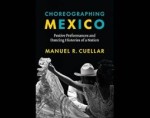
Locating the Body in Postrevolutionary Mexico
by Amy Schofield
I first encountered José Luis Reynoso’s research in my PhD coursework when I read his 2014 article “Choreographing Modern Mexico: Anna Pavlova in Mexico City (1919),” which analyzes how Pavlova’s balletic interpretations of Mexican folk dance allowed Mexican elites to experience cultural uniqueness while participating in international cosmopolitanism. I was excited to see that Reynoso’s first book, Dancing Mestizo Modernisms: Choreographing Postcolonial and Postrevolutionary Mexico (2024), begins with a similar anecdote about Pavlova’s time in Mexico. I was hooked and hungry to learn more about how dance contributed to both Mexican modernism and nationalism in the twentieth century.
The terms mestizaje and mestizo/a/x usually refer to processes of cultural and biological mixing between Indigenous peoples of the Americas and Europeans, a frequently forced process that began in the sixteenth century. These can be fraught terms in Latin American and Latina/o/x studies because of associations with eugenics, the essentialization of Latinx identities, and the invisibilization of Africanist and Asian influences within latinidad. By focusing on embodiment, space, and international influences, however, Reynoso avoids these pitfalls, instead reframing mestizaje as potentially decolonial and pluriversal. Drawing from Walter Mignolo’s theorizations of decoloniality as connected to modernity, this book embraces the complex histories of Mexican dance and substantially contributes to the field of dance studies.
Dancing Mestizo Modernisms moves away from biological conceptions of mestizaje and focuses on identity formation through cultural practice, arguing that “dancers, choreographers, and dancing bodies do not merely reflect societal values but are cultural agents capable of creating meaning in particular ways” (p. 6; emphasis in original). The book insists that dance and embodiment can both produce and resist ideas of race and class in Mexico. The book’s first chapter, for example, concentrates on what Reynoso terms “spatial mestizaje.” For Reynoso, the interactions between diverse bodies in spaces of performance and everyday life produce and activate diverse ways of being, thus enacting a sense of agency within mestizaje, rather than biological fixity.
While not a comprehensive history, this book covers over one hundred years of dance in Mexico—from 1821, when Mexico gained independence from Spain, through the 1940s—and touches on the present day. Organized in loose chronological order, historical context is provided throughout, allowing the book to cover a large time period while supporting readers who may not have previous knowledge of Mexican history. Dancing Mestizo Modernisms threads two main concepts throughout: “embodied mestizo modernisms” and “transnational nationalisms.” Together, these highlight how local and international dancers choreographed Mexican nationalism by weaving folkloric and indigenous dance with European ballet or modern dance aesthetics as a way of looking to a perceived “past” to gesture towards a modern future. The book’s second chapter analyzes the ways indigenous dance was presented in the 1910 Centennial parades as “performances of racial difference, tradition, and modernity” (p. 81). The second half of Dancing Mestizo Modernisms focuses on the ways local and international dance artists in the 1930s and early 1940s deployed ideas of race and revolutionary aesthetics in their work. By analyzing artists such as Anna Pavlova, the Campobello sisters, and Anna Sokolow, this section of the book highlights foreign and transnational influences on the construction of Mexico as a modern “mestizo” state. Finally, the book’s coda takes these concepts into the present day, where Reynoso looks to Mexican diasporic dance in the United States to touch on US Latinx racialization.
Dancing Mestizo Modernisms would be a great companion to the last monograph I reviewed for thINKingDANCE, Manuel Cuellar’s Choreographing Mexico: Festive Performances and Dancing Histories of a Nation. Like Cuellar, Reynoso is interested in the ways mestizaje has been understood through how diverse forms of embodiment functioned in public spaces, but where Cuellar analyzes these danced happenings to understand lo mexicano (Mexicanness), Reynoso is more interested in the specific ideas of mestizaje and their connections to concepts of global modernity through the intersections of gender, race, and embodiment.
While scholars from other disciplines have studied Mexican nationalism and modernism by analyzing muralism, music, poetry, and literature, this book adds to the discourse by focusing on dance. The book admits some of its shortcomings in its introduction, such as its lack of attention to Africanist and Asian influences on Mexican culture. Though Reynoso acknowledges that conceptualizations of mestizaje have commonly excluded African and Asian influences, his research does little to remedy this. Beyond brief discussions of the cakewalk and Japanese choreographer Michio Ito’s 1934 performances in Mexico City, he provides footnotes to African and Asian diasporic influences on Mexican life and culture. More explicit incorporation of these ideas into his project would have been even more comprehensive. While I appreciate Reynoso’s gesture to the decolonial and pluriversal possibilities of mestizaje, I found myself craving this theme to be threaded more explicitly throughout the work. Dancing Mestizo Modernisms' use of theory and principles from dance studies makes it an important contribution to Mexican historiography, but may prove a hindrance for those unfamiliar with the field. I would, however, recommend this heavily footnoted work for people wanting to learn about Mexican concert dance history, global modern dance, and how dance and performance impact collective national identity.
Article image credit: Edmée Pérez, Gloria Mestre, Ana Mérida, and Evelia Beristaín in the “Dance of the Disinherited," a section of La Coronela, Mexico City, c. 1950. Photographer, Simón Flechine SEMO. Courtesy of Instituto Nacional de Antropología e Historia.
José Juis Reynoso, Dancing Mestizo Modernisms: Choreographing Postcolonial and Postrevolutionary Mexico. New York: Oxford University Press, 2024. 275pp.
By Amy Schofield
January 17, 2024






.png)


